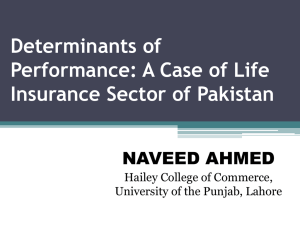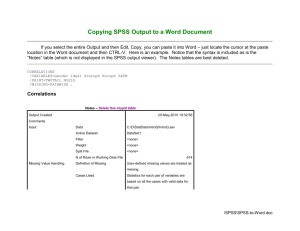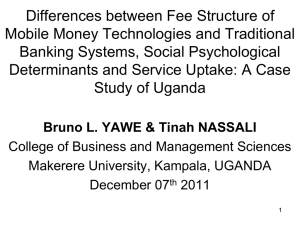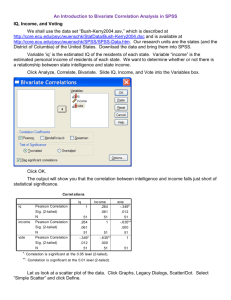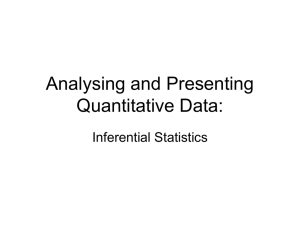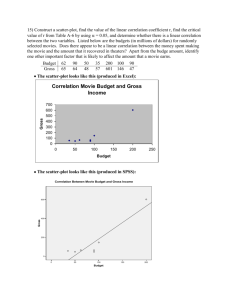Liu, N. H., Choi, K. H., Kleinlein, P., & Spaulding, W.
advertisement
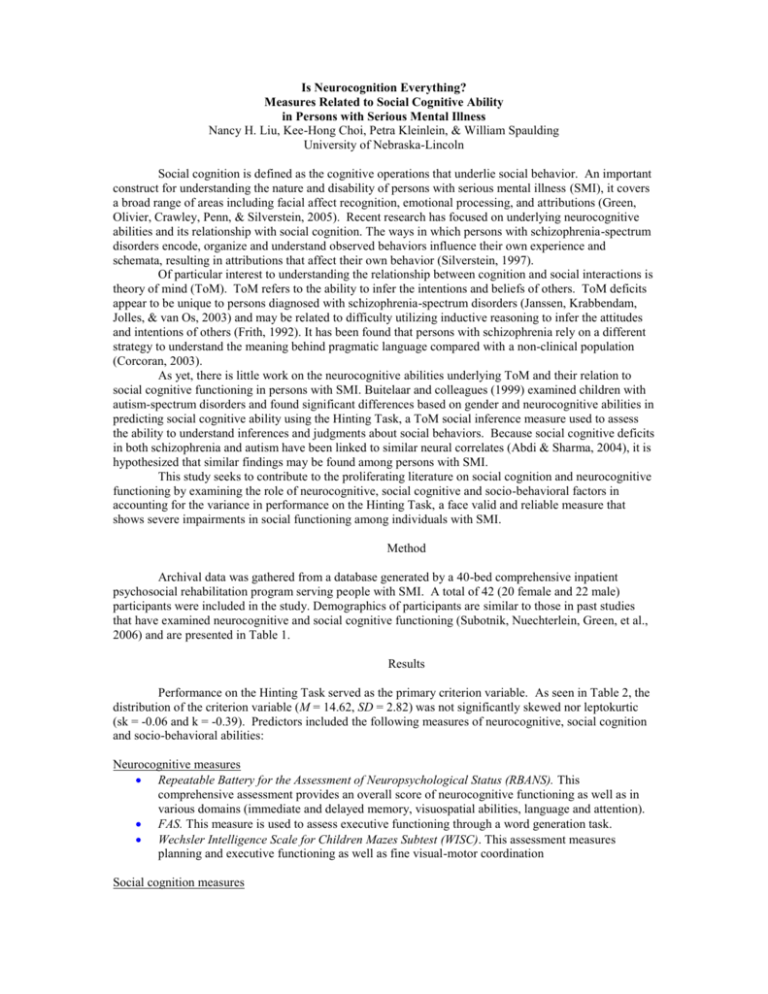
Is Neurocognition Everything? Measures Related to Social Cognitive Ability in Persons with Serious Mental Illness Nancy H. Liu, Kee-Hong Choi, Petra Kleinlein, & William Spaulding University of Nebraska-Lincoln Social cognition is defined as the cognitive operations that underlie social behavior. An important construct for understanding the nature and disability of persons with serious mental illness (SMI), it covers a broad range of areas including facial affect recognition, emotional processing, and attributions (Green, Olivier, Crawley, Penn, & Silverstein, 2005). Recent research has focused on underlying neurocognitive abilities and its relationship with social cognition. The ways in which persons with schizophrenia-spectrum disorders encode, organize and understand observed behaviors influence their own experience and schemata, resulting in attributions that affect their own behavior (Silverstein, 1997). Of particular interest to understanding the relationship between cognition and social interactions is theory of mind (ToM). ToM refers to the ability to infer the intentions and beliefs of others. ToM deficits appear to be unique to persons diagnosed with schizophrenia-spectrum disorders (Janssen, Krabbendam, Jolles, & van Os, 2003) and may be related to difficulty utilizing inductive reasoning to infer the attitudes and intentions of others (Frith, 1992). It has been found that persons with schizophrenia rely on a different strategy to understand the meaning behind pragmatic language compared with a non-clinical population (Corcoran, 2003). As yet, there is little work on the neurocognitive abilities underlying ToM and their relation to social cognitive functioning in persons with SMI. Buitelaar and colleagues (1999) examined children with autism-spectrum disorders and found significant differences based on gender and neurocognitive abilities in predicting social cognitive ability using the Hinting Task, a ToM social inference measure used to assess the ability to understand inferences and judgments about social behaviors. Because social cognitive deficits in both schizophrenia and autism have been linked to similar neural correlates (Abdi & Sharma, 2004), it is hypothesized that similar findings may be found among persons with SMI. This study seeks to contribute to the proliferating literature on social cognition and neurocognitive functioning by examining the role of neurocognitive, social cognitive and socio-behavioral factors in accounting for the variance in performance on the Hinting Task, a face valid and reliable measure that shows severe impairments in social functioning among individuals with SMI. Method Archival data was gathered from a database generated by a 40-bed comprehensive inpatient psychosocial rehabilitation program serving people with SMI. A total of 42 (20 female and 22 male) participants were included in the study. Demographics of participants are similar to those in past studies that have examined neurocognitive and social cognitive functioning (Subotnik, Nuechterlein, Green, et al., 2006) and are presented in Table 1. Results Performance on the Hinting Task served as the primary criterion variable. As seen in Table 2, the distribution of the criterion variable (M = 14.62, SD = 2.82) was not significantly skewed nor leptokurtic (sk = -0.06 and k = -0.39). Predictors included the following measures of neurocognitive, social cognition and socio-behavioral abilities: Neurocognitive measures Repeatable Battery for the Assessment of Neuropsychological Status (RBANS). This comprehensive assessment provides an overall score of neurocognitive functioning as well as in various domains (immediate and delayed memory, visuospatial abilities, language and attention). FAS. This measure is used to assess executive functioning through a word generation task. Wechsler Intelligence Scale for Children Mazes Subtest (WISC). This assessment measures planning and executive functioning as well as fine visual-motor coordination Social cognition measures Questionnaire of Competence and Control Orientation (FKK). This assessment measures locus of control and contains subscales that include internal, self-concept, self-efficacy, chance and externality. Socio-behavioral measures Nurses’ Observation Scale for Inpatient Evaluation-30 (NOSIE-30). Consisting of 30 items, this instrument is a psychiatric ward behavior rating scale that was formulated by Honigfeld et al. (1966). Items are grouped into six factor-analytically derived subscales: social competence, social interest, neatness, irritability, psychosis and motor retardation. An initial set of bivariate correlational analyses were examined to identify whether the key neurocognitive, social cognitive and socio-behavioral variables were related to performance on the Hinting Task. The descriptives for these statistics are presented in Table 3. The only significant correlates of performance on the Hinting Task appeared to be scores of the RBANS Total (r = .390, p < .05), RBANS Story Recall subtest (r = .368, p < .05), Language subtest (r = .370, p < .05), Immediate Memory subtest, (r = .355, p < .05) and Story Memory subtest (r = .358, p < .05). Of the various other measures used to assess attention, visuospatial abilities, executive functioning, locus of control and social behavior ratings, no other significant bivariate correlations were found. To determine which of the different neurocognitive, social cognitive and socio-behavioral variables made independent contributions in predicting of performance on the Hinting Task, these variables were entered into a multiple regression model. Because subtests of the RBANS are highly correlated, a stepwise approach was used to avoid variance accounted for due to collinearity effects. As seen in Table 4, the RBANS Total score was found to significantly account for 15.2 % of the variance in performance on the Hinting Task. List learning, story memory, immediate memory, story recall, figure copy, line orientation, picture naming, fluency, language, coding, attention, visuospatial abilities, and delayed memory subtests of the RBANS were not found to be significant. Tasks of executive functioning and planning, the FAS and WISC mazes, were not found to be a significant predictor in the overall model. Similarly, socio-behavioral abilities as measured by the NOSIE-30 were also not found to be significant. From this study, overall cognitive functioning appears to be contributing to 15.2 % of the variance found in performance on the Hinting Task. Table 1. Demographics and Symptomatology of Participants Mean (SD) N = 42 Years of Education Number of Previous Hospitalizations Age of Onset BPRS Total Score Table 2. Distribution of the Criterion Variable Hinting Task Time 1 14 12 10 8 Frequency 6 4 Std. Dev = 2.83 2 Mean = 14.6 N = 42.00 0 8.0 10.0 12.0 14.0 16.0 18.0 20.0 Hinting Task Time 1 12.95 (2.14) 7.00 (4.78) 22.98 (9.02) 43.22 (7.76) Table 3. Neurocognitive, social cognitive and social behavioral correlates of performance on Hinting Task Measure Mean (SD) Neurocognitive measures RBANS List Learning 22.36 (6.40) Pearson correlation Sig. (2-tailed) RBANS Story Memory 13.29 (4.35) Pearson correlation Sig. (2-tailed) RBANS Immediate Memory 74.83 (18.10) Pearson correlation Sig. (2-tailed) RBANS Figure Copy 15.17 (3.72) Pearson correlation Sig. (2-tailed) RBANS Line Orientation 14.95 (4.45) Pearson correlation Sig. (2-tailed) RBANS Visuospatial/Construction 79.95 (19.47) Pearson correlation Sig. (2-tailed) RBANS Picture Naming 9.50 (.741) Pearson correlation Sig. (2-tailed) RBANS Fluency 17.17 (4.73) Pearson correlation Sig. (2-tailed) RBANS Language 87.36 (14.85) Pearson correlation Sig. (2-tailed) RBANS Digit Span 9.21 (2.51) Pearson correlation Sig. (2-tailed) RBANS Coding 35.95 (10.47) Pearson correlation Sig. (2-tailed) RBANS Attention 72.95 (17.36) Pearson correlation Sig. (2-tailed) RBANS List Recall 4.57 (2.63) Pearson correlation Sig. (2-tailed) RBANS List Recognition 18.19 (2.60) Pearson correlation Sig. (2-tailed) RBANS Story Recall 7.45 (2.92) Pearson correlation Sig. (2-tailed) RBANS Figure Recall 10.60 (4.62) Pearson correlation Sig. (2-tailed) RBANS Delayed Memory 78.43 (21.16) Pearson correlation Sig. (2-tailed) FAS 28.76 (11.13) Pearson correlation Sig. (2-tailed) WISC Mazes 17.76 (5.94) Pearson correlation Sig. (2-tailed) Social Cognitive Measures FKK Internal 34.05 (6.56) Pearson correlation Sig. (2-tailed) FKK Self-Concept 33.74 (5.11) Pearson correlation Sig. (2-tailed) FKK Self Efficacy 67.79 (9.89) Pearson correlation (Internality + Self-Concept) Sig. (2-tailed) FKK Powerful Others 25.60 (7.62) Pearson correlation Sig. (2-tailed) FKK Chance 23.33 (7.04) Pearson correlation Sig. (2-tailed) FKK Externality 48.93 (12.96) Pearson correlation (Powerful Others + Chance) Sig. (2-tailed) Social Behavioral Measures NOSIE Daily Schedule 36.03 (2.96) NOSIE Social Interest 18.22 (6.41) NOSIE Neatness 25.81 (3.82) NOSIE Irritability 2.70 (3.78) NOSIE Psychoticism .93 (2.26) NOSIE Motor Retardation 4.47 (2.81) Pearson correlation Sig. (2-tailed) Pearson correlation Sig. (2-tailed) Pearson correlation Sig. (2-tailed) Pearson correlation Sig. (2-tailed) Pearson correlation Sig. (2-tailed) Pearson correlation Sig. (2-tailed) Hinting Task .285 .067 .358* .020 .355* .021 .120 .449 .076 .632 .317 .041 .279 .073 .217 .168 .370* .016 .262 .093 .052 .743 .327* .035 .171 .280 .087 .586 .368* .017 .255 .103 .271 .082 .199 .206 .079 .621 .056 .723 .096 .546 .087 .584 -.035 .828 -.147 .354 -.100 .529 .194 .219 -.035 .827 .237 .130 .017 .914 -.056 .724 -.146 -.357 Table 4. Multiple regression model for neurocognitive factors and performance on Hinting Task R2 df B Overall Model .152 1, 41 NA Constant -RBANS Total .390 p .011 -.011 Discussion These results indicate that overall neurocognitive functioning accounts for a portion of the variance in social cognition and social inference as measured by performance on the Hinting Task. Functioning in specific neurocognitive domains such as immediate and delayed memory, attention, visuospatial abilities, language and executive functioning were not found to significantly contribute to the overall model. The fact that a specific neurocognitive ability was unable to be specified may point towards underlying latent factors that possibly exist that as of yet, neurocognitive assessments have been unable to identify—more specifically, those related to social inference and social cognitive abilities. It is also possible however, that an assessment of more global neurocognitive functioning is more predictive of social cognitive abilities than specific functioning in any particular domain. That the social cognitive measure of locus of control was not found to be significant related to this social inference measure brings up the question of whether locus of control is related to the social inference abilities measured by the Hinting Task. Separate domains of social cognition may also exist, however these domains should be correlated in order to be labeled under the more general rubric of social cognition. While overall neurocognitive functioning appears to account for a significant amount of variance in this social inference measure, 85% of the variance was not accounted for through these various neurocognitive, social cognitive and socio-behavioral measures. Future studies should increase the number of measures used to assess each of these domains of functioning in order to maximize our understanding of their relationships with social cognitive abilities. References Abdi, Z. & Sharma, T. (2004). Social cognition and its neural correlates in schizophrenia and autism. CNS Spectrums, 9, 335-343. Buitelaar, J. K., van der Wees, M., Swaab-Barneveld, H., & van der Gaag, R. J. (1999). Verbal memory and performance IQ predict theory of mind and emotion recognition ability in children with autistic spectrum disorders and in psychiatric control children. Journal od Child Psychology and Psychiatry, 40, 869-881. Corcoran, R. (2003). Inductive reasoning and the understanding of intention in schizophrenia. Cognitive Neuropsychiatry, 8, 223-235. Green, M. F., Olivier, B., Crawley, J. N., Penn, D. L., & Silverstein, S. (2005). Social cognition in schizophrenia: Recommendations from the measurement and treatment research to imporove cognition in schizophrenia new approaches conference. Schizophrenia Bulletin, 31, 882-887. Frith, K. (1992). The cognitive neuropsychology of schizophrenia. Hove, UK: Psychology Press. Janssen, I., Krabbendam, L., Jolles, J., & van Os, J. (2003). Alterations in theory of mind in patients with schizophrenia and non-psychotic relatives. Acta Psychiatrica Scandinavia, 108, 110-117. Silverstein, S. (1997). Information processing, social cognition, and psychiatric rehabilitation in schizophrenia. Psychiatry, 60, 327-340. Subotnik, K. L., Nuechterlein, K. H., Green, F. M., Horan, W. P., Nienow, T. M., Ventura, J., & Nguyen, A. T. (2006). Neurocognitive and social cognitive correlates of formal thought disorder in schizophrenia patients. Schizophrenia Research, 85, 84-95. Please send inquiries to nancyhhliu@gmail.com.
